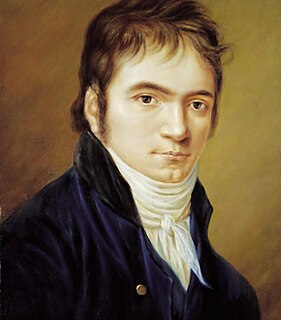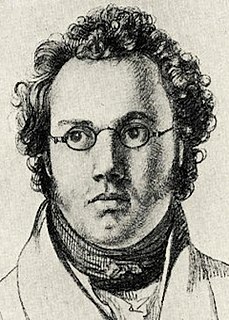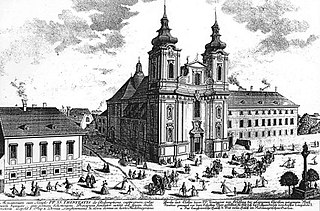Movements
There are four movements:

- (The true marking is fzp rather than fp, but that is not available in LilyPond as implemented on Wikipedia.)
A typical performance lasts around 32 minutes.
The Symphony No. 6 in C major, D 589, [1] is a symphony by Franz Schubert composed between October 1817 and February 1818. [2] Its first public performance was in Vienna in 1828. It is nicknamed the "Little C major" to distinguish it from his later Ninth Symphony, in the same key, which is known as the "Great C major".
The symphony is scored for two flutes, two oboes, two clarinets (in C), two bassoons, two horns (in C), two trumpets (in C), timpani (in C and G) and strings.
There are four movements:

A typical performance lasts around 32 minutes.

The Symphony No. 2 in D major, Op. 36, is a symphony in four movements written by Ludwig van Beethoven between 1801 and 1802. The work is dedicated to Karl Alois, Prince Lichnowsky.

Franz Schubert's Symphony No. 5 in B♭ major, D. 485, was written mainly in September 1816 and completed on October 3, 1816. It was finished six months after the completion of his previous symphony.

The Symphony No. 9 in C major, D 944, known as the Great(first published by Breitkopf & Härtel in 1849 as "Symphonie / C Dur / für großes Orchester",listed as Symphony No. 8 in the Neue Schubert-Ausgabe), is the final symphony completed by Franz Schubert. Originally called The Great C major to distinguish it from his Symphony No. 6, the Little C major, the subtitle is now usually taken as a reference to the symphony's majesty. Unusually long for a symphony of its time, a typical performance of The Great lasts an hour when all repeats indicated in the score are taken. The symphony was not professionally performed until a decade after Schubert's death.

Franz Schubert's Symphony No. 8 in B minor, D. 759, commonly known as the Unfinished Symphony, is a musical composition that Schubert started in 1822 but left with only two movements—though he lived for another six years. A scherzo, nearly completed in piano score but with only two pages orchestrated, also survives.

Franz Schubert's final chamber work, the String Quintet in C major is sometimes called the "Cello Quintet" because it is scored for a standard string quartet plus an extra cello instead of the extra viola which is more usual in conventional string quintets. It was composed in 1828 and completed just two months before the composer's death. The first public performance of the piece did not occur until 1850, and publication occurred three years later in 1853. Schubert's only full-fledged string quintet, it has been praised as "sublime" or "extraordinary" and as possessing "bottomless pathos," and is generally regarded as Schubert's finest chamber work as well as one of the greatest compositions in all chamber music.

The Quartettsatz c-Moll D 703 was composed by Franz Schubert in December 1820 as the first movement, Allegro assai, of a string quartet he was never to complete. Upon publication it was nonetheless listed as his "String Quartet No. 12". The nine-minute work is regarded as an early product of the composer's mature phase of output.

The Trio No. 1 in B-flat major for piano, violin, and cello, D. 898, was written by Franz Schubert in 1827. The composer finished the work in 1828, in the last year of his life. It was published in 1836 as Opus 99, eight years after the composer's death. Like the E-flat major trio, it is an unusually large scale work for piano trio, taking around 40 minutes in total to perform.
Symphony No. 7 is the name given to a four-movement symphony in E major drafted by Franz Schubert in August 1821. Although the work is structurally complete, Schubert only orchestrated the slow introduction and the first 110 bars of the first movement. The rest of the work is continued on 14-stave score pages as a melodic line with occasional basses or counterpoints, giving clues as to changes in orchestral texture.
Franz Schubert's Symphony No. 3 in D major, D 200, was written between 24 May and 19 July 1815, a few months after his eighteenth birthday. Like the other early symphonies, it was not published during Schubert's lifetime. It appeared many years later, in the first Schubert complete works edition in 1884. It is scored for 2 flutes, 2 oboes, 2 clarinets, 2 bassoons, 2 horns, 2 trumpets, timpani and strings.
Franz Schubert's Symphony No. 4 in C minor, D 417, called by its composer the Tragic, was completed in April 1816, a year after his Third Symphony, when he was 19 years old. However, it was not premiered until November 19, 1849, in Leipzig, more than two decades after Schubert's death.
The Symphony No. 1 in D major, D 82, was composed by Franz Schubert in 1813, when he was just 16 years old. Despite his youth, his first symphony is an impressive piece of orchestral music for both its time and size. The first movement opens with a stately Adagio introduction, reminiscent of Joseph Haydn's 104th symphony in its format. The short Adagio sets off a lively Allegro vivace.

The Fantasia in F minor by Franz Schubert, D.940, for piano four-hands, is one of Schubert's most important works for more than one pianist and one of his most important piano works altogether. He composed it in 1828, the last year of his life, and dedicated it to his pupil Caroline Esterházy.
The Symphony No. 2 in B♭ major, D 125, is a symphony by Franz Schubert composed between 1814 and 1815. It is scored for 2 flutes, 2 oboes, 2 clarinets, 2 bassoons, 2 horns, 2 trumpets, timpani and strings.

The Piano Trio No. 1 in B major, Op. 8, by Johannes Brahms was completed in January 1854, when the composer was only twenty years old, published in November 1854 and premiered on 13 October 1855 in Danzig. It has often been mistakenly claimed that the first performance had taken place in the United States. Brahms produced a revised version of the work in summer 1889 that shows significant alterations so that it may even be regarded as a distinct (fourth) piano trio. This "New Edition", as he called it, was premiered on 10 January 1890 in Budapest and published in February 1891.
The Violin Sonata No. 4 in A major, Op. posth. 162, D 574, for violin and piano by Franz Schubert was composed in 1817. This sonata, composed one year after his first three sonatas for the same instruments, is a much more individual work, showing neither the influence of Mozart, as in these previous works, or of Rossini, as in the contemporaneous 6th Symphony.
Brian Newbould is a composer, conductor and author who has conjecturally completed Franz Schubert's Symphonies D 708A in D major, No. 7 in E major, No. 8 in B minor ("Unfinished") and No. 10 ("Last") in D major. He was educated at Gravesend Grammar School, and earned a BMus degree with top honors from the University of Bristol.

Stabat Mater in F minor, D 383, is a musical setting of the Stabat Mater sequence, composed by Franz Schubert in 1816. It is scored for soprano, tenor and bass soloists, SATB choir, 2 flutes, 2 oboes, 2 bassoons, contrabassoon, 2 french horns, 3 trombones, violin I and II, viola, cello and double bass.

Mass No. 4 in C major, D 452, is a mass composed by Franz Schubert in 1816. It was originally scored for soprano, alto, tenor and bass soloists, SATB choir, violin I and II, and basso continuo. It is classified as a missa solemnis.

Mass No. 6 in E-flat major, D 950, is a mass composed by Franz Schubert, a few months before his death. It is scored for two tenor soloists, soprano, alto and bass soloists, SATB choir with divisi, 2 oboes, 2 clarinets, 2 bassoons, 2 horns, 2 trumpets, 3 trombones, timpani, violin I and II, viola, cello, and double bass. It was Schubert's final setting of the order of Mass, and is classified as a missa solemnis.

Franz Schubert wrote three string trios, all of them in the key of B-flat major. From the first of these, D 111A, a trio Schubert wrote in 1814, only a few measures are extant. The string trio D 471 consists of a completed first movement and an incomplete second movement, composed in 1816. The last of these trios, D 581, was completed in four movements, exists in two versions and was composed in 1817.